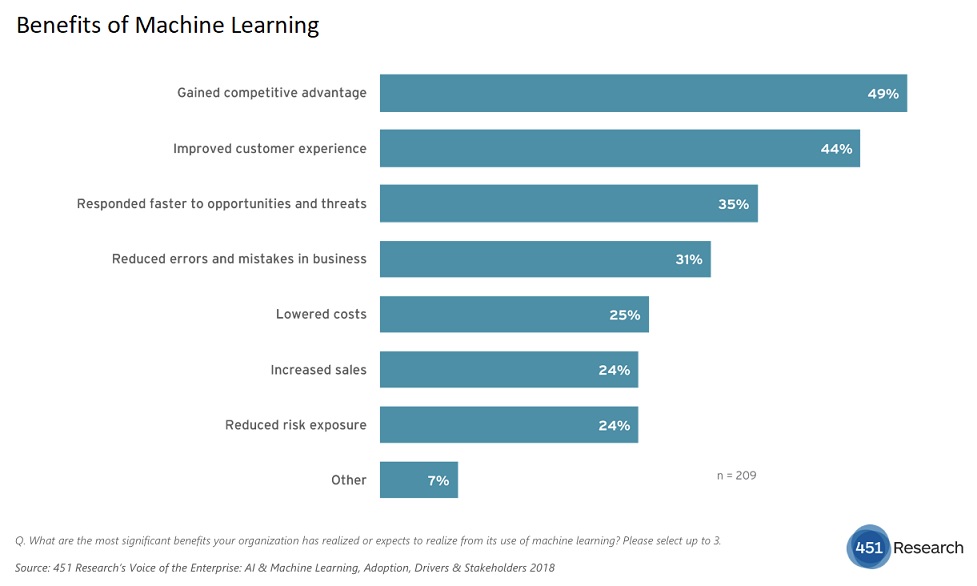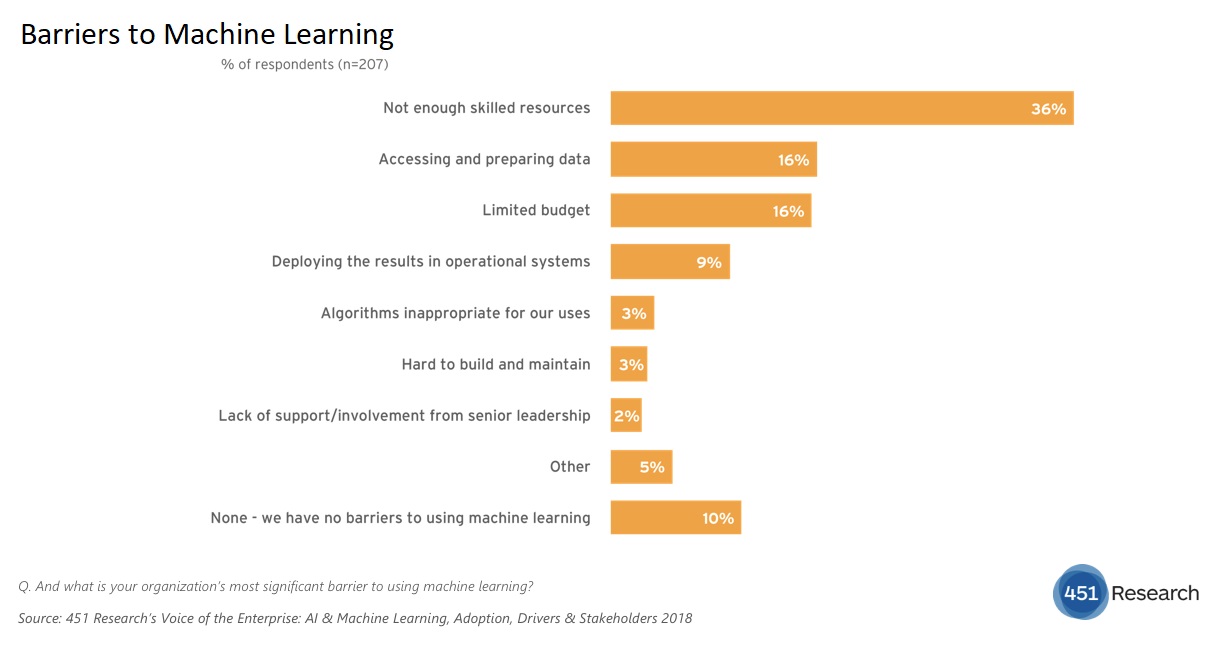Most organizations are adopting or considering adopting machine learning due to its benefits, rather than with the intention to cut people’s jobs, according to the Voice of the Enterprise (VoTE): AI & Machine Learning – Adoption, Drivers and Stakeholders 2018 survey conducted by 451 Research. Despite being new, there is a healthy amount of adoption of these technologies already. Almost 50% of survey respondents have deployed or plan to deploy machine learning in their organizations within the next 12 months. According to Nick Patience, founder and research vice president for software at 451 Research, this paints a more realistic picture of machine learning adoption than is often portrayed. Out of many possible benefits presented to survey respondents, almost half (49%) cited gaining competitive advantage as the most significant benefit they have received from the technology. Improving the customer experience came a close second, cited by 44% of respondents. Despite all the hype around mass job losses, lowering costs was cited by only a quarter of our survey respondents. According to 451 Research, this demonstrates that AI and machine learning is an omni-purpose technology that can bring numerous benefits to organizations, beyond just lowering costs through increased automation. 
Alternatively, respondents say the most significant benefit they realized or expect to realize are competitive advantages (49%) and an improved user experience for their customers (44%). This seems to indicate that decision-makers care more about the long-term impact that comes from gaining and retaining customers rather than a short-term fix that comes from cutting costs. 
There are some barriers, however. When asked "what is your organization’s most significant barrier to using machine learning?" most cited a shortage of skilled resources as the top barrier (36%). Skilled resources in the context of machine learning usually means data science skills. And a lack of those skills is reinforced further by the finding that data access and preparation is the second biggest barrier cited by survey respondents. 451 Research expects the lack of skills to gradually decline as a barrier as tools become easier to use and the population of users who can leverage machine learning expands. When all is said and done, organizations large and small will need more personnel to ensure their machine learning deployment brings the business benefits that matter most. About Voice of the Enterprise (VoTE): AI and Machine Learning: This newest VoTE survey research report provides actionable data and insight and a broad, integrated view of enterprise AI/machine learning strategies and initiatives, their underlying business and technology driver, and the nature, pace and direction of AI/machine learning adoption. Data was collected via roughly 550 web-based surveys conducted with IT end-user decision-makers around the world from small, midsize and large enterprises in both private and public sectors.
Machine Learning: The Top Benefits and Barriers
The Latest
Overall outage frequency and the general level of reported severity continue to decline, according to the Outage Analysis 2025 from Uptime Institute. However, cyber security incidents are on the rise and often have severe, lasting impacts ...
In March, New Relic published the State of Observability for Media and Entertainment Report to share insights, data, and analysis into the adoption and business value of observability across the media and entertainment industry. Here are six key takeaways from the report ...
Regardless of their scale, business decisions often take time, effort, and a lot of back-and-forth discussion to reach any sort of actionable conclusion ... Any means of streamlining this process and getting from complex problems to optimal solutions more efficiently and reliably is key. How can organizations optimize their decision-making to save time and reduce excess effort from those involved? ...
As enterprises accelerate their cloud adoption strategies, CIOs are routinely exceeding their cloud budgets — a concern that's about to face additional pressure from an unexpected direction: uncertainty over semiconductor tariffs. The CIO Cloud Trends Survey & Report from Azul reveals the extent continued cloud investment despite cost overruns, and how organizations are attempting to bring spending under control ...

According to Auvik's 2025 IT Trends Report, 60% of IT professionals feel at least moderately burned out on the job, with 43% stating that their workload is contributing to work stress. At the same time, many IT professionals are naming AI and machine learning as key areas they'd most like to upskill ...
Businesses that face downtime or outages risk financial and reputational damage, as well as reducing partner, shareholder, and customer trust. One of the major challenges that enterprises face is implementing a robust business continuity plan. What's the solution? The answer may lie in disaster recovery tactics such as truly immutable storage and regular disaster recovery testing ...
IT spending is expected to jump nearly 10% in 2025, and organizations are now facing pressure to manage costs without slowing down critical functions like observability. To meet the challenge, leaders are turning to smarter, more cost effective business strategies. Enter stage right: OpenTelemetry, the missing piece of the puzzle that is no longer just an option but rather a strategic advantage ...
Amidst the threat of cyberhacks and data breaches, companies install several security measures to keep their business safely afloat. These measures aim to protect businesses, employees, and crucial data. Yet, employees perceive them as burdensome. Frustrated with complex logins, slow access, and constant security checks, workers decide to completely bypass all security set-ups ...

In MEAN TIME TO INSIGHT Episode 13, Shamus McGillicuddy, VP of Research, Network Infrastructure and Operations, at EMA discusses hybrid multi-cloud networking strategy ...
In high-traffic environments, the sheer volume and unpredictable nature of network incidents can quickly overwhelm even the most skilled teams, hindering their ability to react swiftly and effectively, potentially impacting service availability and overall business performance. This is where closed-loop remediation comes into the picture: an IT management concept designed to address the escalating complexity of modern networks ...
